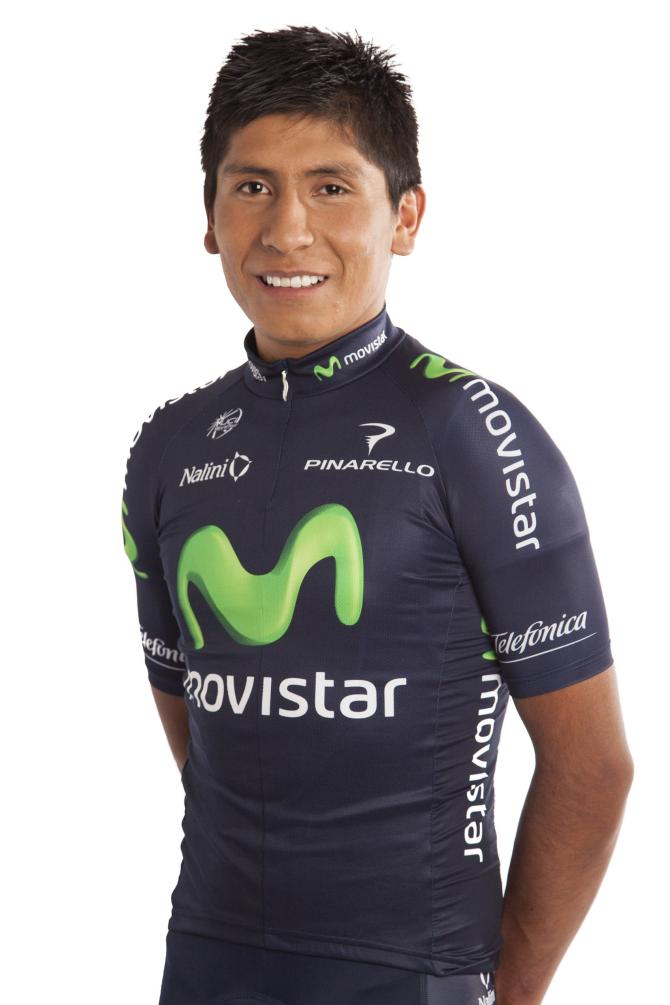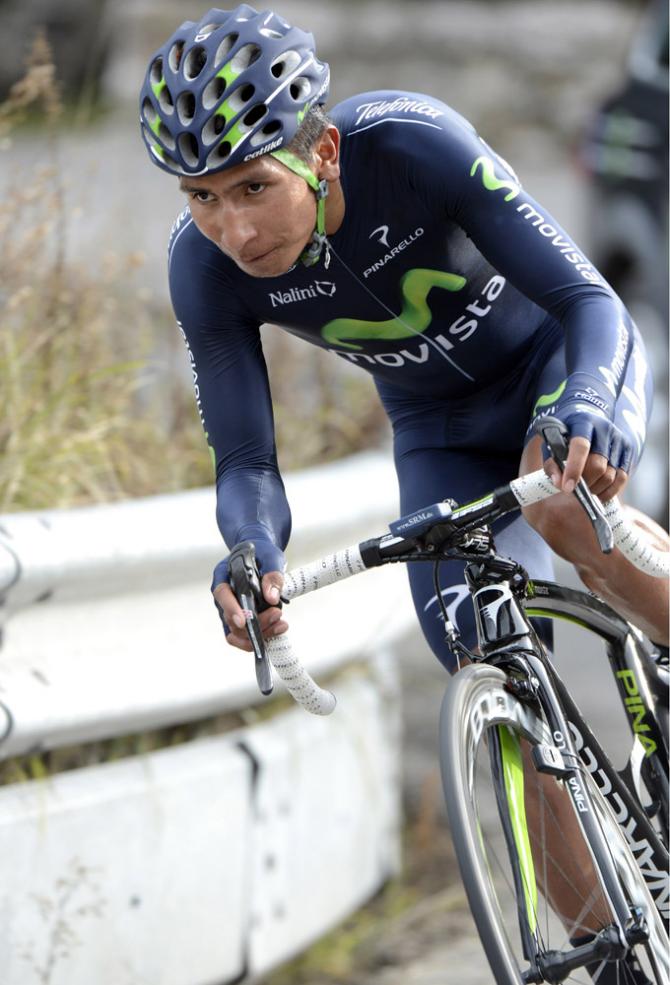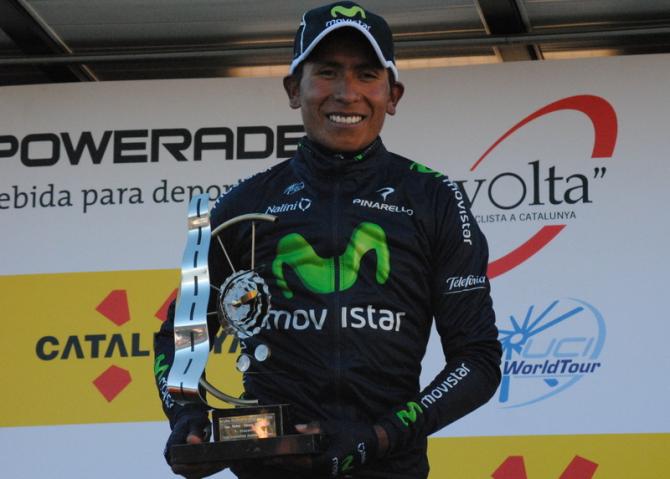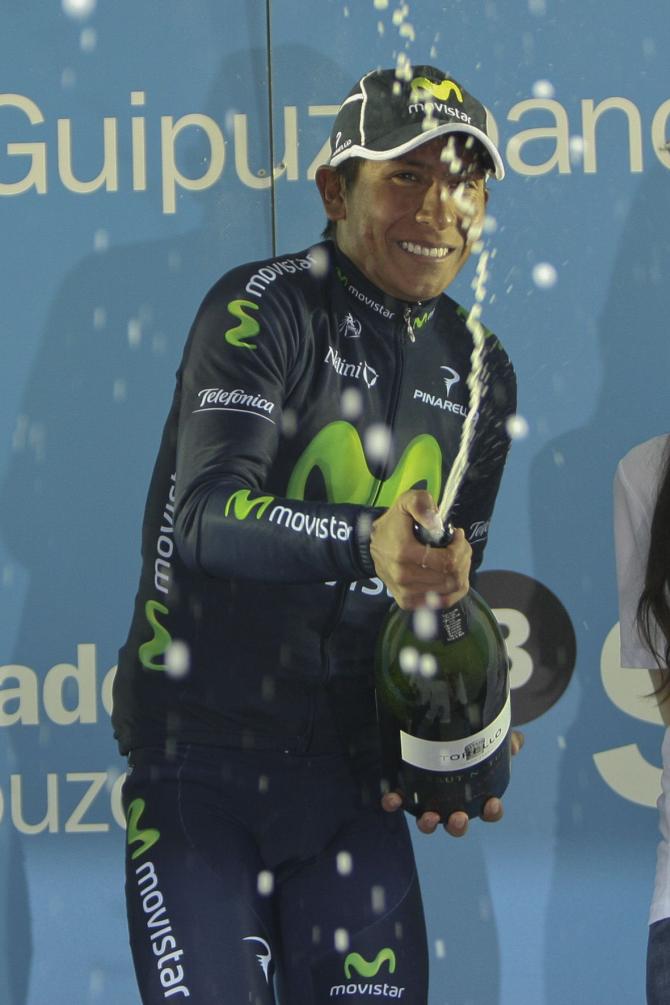Tour de France 2013: Nairo Quintana: the outsider
A profile of the Colombian climber that has Team Sky worried




This feature first appeared in this month's edition of ProCycling magazine.
During the final segment of Bradley Wiggins faultless build-up for the 2012 Tour de France - at the Criterium du Dauphiné - Team Sky only once came up against a rider who not only refused to turn over and be beaten, but who also succeeded.
On the race’s most mountainous stage Nairo Quintana (Movistar) charged away on the Col de Joux Plane, the single hardest climb of that year’s Dauphiné. Yet for all Team Sky laid down a relentless pace behind designed to wipe out any rival attacks - which, barring a late downhill move by Cadel Evans, largely managed to do - Quintana reached the finish ahead of both the Australian and the Sky-led main pack.
Up until that point, Sky had won almost everything they wanted to in the Dauphiné, which they completed with the overall victory and three riders in the top four. But if Quintana constituted a minor fly in the ointment for Sky last June given he was so far behind overall, in the Vuelta al País Vasco this April, his stage victory ahead of Sergio Henao and Richie Porte had a far more devastating effect on the British. Against almost all expectations, he won outright.
Quintana’s team-mates in Movistar feel that the 23-year-old Colombian has a huge margin of progression. Juan Jose Cobo, the only rider to beat Sky’s combined ‘A’ team of Wiggins+Froome in a three-week stage race, back in the 2011 Vuelta points out that “Last year Nairo was with Alejandro [Valverde] right up until the last climbs in his debut Grand Tour “- with one particular high point being when Quintana took sixth on the race’s toughest ascent, the Cuitu Negru, after working for his team leader. “That means he’s got it in him to win in major Tours.”
This year, Quintana is being groomed for the Tour de France, a race where one top name in Sky’s management admitted to ProCycling that he considered the Colombian so dangerous “we won’t be giving him any room for manouvre at all.”
They could be right to do that, given Quintana is not just a gifted climber. As Cobo points out, “in his first month with us [2012] he was already capable of winning a stage race, the Vuelta a Murcia. What surprised us wasn’t so much that he could take the mountainous stage” - as he did, taking the lead with it - “but that he was so unstressed about the time trial that followed. We knew that he was a climber all right, but not that he could do so well in the time trialling.” Sky, too, were to find this out at the Vuelta al País Vasco, where Porte and Henao looked set to win outright until Quintana claimed the final victory thanks to winning the last, technically very difficult, race against the clock.
The latest race content, interviews, features, reviews and expert buying guides, direct to your inbox!
Growing up in Colombia
If Quintana’s all round abilities are what make him so dangerous as a three week stage race contender, his first eye-catching result in Europe came in the Subida a Urkiola in 2009, a sadly defunct summit finish race that acted as a revenge match for the Clasica San Sebastian, held 24 hours earlier. On Urkiola, probably the steepest climb of the Basque Country, and riding for a tiny South American squad, Boyaca es Para Vivirla (Boyaca is a place to go and see), aged 19, Quintana placed seventh.
“It was the biggest race the team got to do that year,” Quintana recalls, “I was pretty young and I’d only just turned pro. that summer. To be honest, I never imagined it, but that was where I started taking my first steps. That result opened me a lot of doors.”
It is one of the best-known cycling cliches that riders who have come from a very poor background tend to be hungrier for success in cycling. In Quintana’s case, given that he began working almost as soon as he could walk, helping his father - who is disabled - work as a wholesale fruit merchant in rural Colombia shifting cartloads of vegetables, the cliche happens to be true. But he doesn’t see his upbringing as having been excessively hard.
“Yes, we did work from a very young age. One of my earliest memories is sitting in a bus surrounded by other farm workers and sacks of fruit and vegetables. But it wasn’t all bad, it’s like anything, once you start doing it, you get used to it. We had some good times”
On two wheels as well as four, there were other experiences there in his hometown of Combita, northeast of Bogota, that helped forge his endurance level as a pro. For example there was how he had to ride down one mountain and up another mountain pass, a mere 16 kilometres long, every time he went to school - an education which, like so many young Colombians, he combined with his ‘day-job’ of working to help the family, making for very long hours for a teenager.
“Combita itself is at around 1,700 metres above sea level, but my parents house was a lot further up the mountain, at 3,000 metres. So to go to school, in another town called Arcabuco, I had to go up that climb, which was around eight percent average gradient and 16 kilometres long, every day. And then it was 16 kilometres downhill again. I did that every day for three years, from 15 to 18. And when I was 17, too, that was what got me interested in riding a bike anyway.”
There was no tradition, he says, in his family, of racing or riding. “It had never occured to me.” But given the climb he had to tackle on his ‘school run’ was so hard, groups of normal amateur riders would use it, and one day he decided to tag along with some riders on a training run to see how well he could match against them.
“They started accelerating and accelerating and they couldn’t drop me,” he recalls with just a hint of pride in his quietly spoken voice. “So I got home, I told my dad, and he was very pleased. He bought me a racing bike and then we went on to village races.”
He went straight from junior to a Continental level with the Boyaca squad, who snapped him up after he took third in the Colombian version of the Tour de L’Avenir, in 2008. That meant Quintana has been used to punching above his weight from a very young age, given he never raced as an amateur, but was already familiar with U-23 events. “As a junior there weren’t many races at my level. I would get fourth or fifth in uphill time trials, once second but I was racing against guys three or four years older than me.”
His next move, into Colombia es Pasión in 2010, came when Boyaca lost sponsorship deal and stopped racing in Europe. “Colomba es Pasión already wanted to sign me in 2009, but Boyaca was my local team. When Boyaca dropped down a category to amateur, though, I could sign with Colombia es Pasión.”
The Tour de L'Avenir
In 2011, having won the Tour de L’Avenir of the European variety the previous year - another important landmark - Quintana then won the mountains prize in the Volta a Catalunya.
“That showed me I was doing ok, without making huge progress. “It also saved his career. Quintana crashed out badly of the Vuelta a Colombia, badly injuring his wrists during a pile-up in the race - “and it still hurts” - and was two months off without racing. But Movistar had had their eye on Quintana since the Tour de L’Avenir - and even more so after Catalunya, and “doing a really good time trial in Castille y Leon on a bike that wasn’t my measure and didn’t even belong to me.” So in 2012, despite having had half the 2011 season off, he signed with the Spanish. The Colombian who started out by riding up 16 kilometre climbs just so he could get an education was finally en route.
“I was in good shape from the first month with Movistar, winning from the Vuelta a Murcia onwards, where I beat some big names like Samuel Sanchez and Roberto Gesink,” he recalls. Quintana has, since then, been the first top Colombian to excel in time trials since Victor Hugo Peña and Santiago Botero, who won the World Championships Time Trial and a Tour de France time trial back in the early noughties. “I did well in Murcia, but I’d already represented Colombia at the World’s in timetrials at U-23 level,” he said, “maybe I’m not a top name, but if you look at the climbers, I’m always up there in the time trials as well.”
Murcia was one breakthrough, but the biggest was without doubt managing to beat Team Sky in the Joux Plane in the Criterium du Dauphine. They were, as Quintana recollects, “way superior to everybody else at the time and they were scarily fast in every stage before that. All we could do was sit on their wheels.”
“But I felt good on the Joux Plane day, I attacked to see what I could get, but the most I could do was 20 or 30 seconds. They were always close behind, Sky were so strong. But nobody else dared attack.”
Confidence for the Tour de France
“Winning there gave me a big dose of confidence, I felt much more sure of myself on the French mountains now,” he says, “straight away after the Dauphine I went onto the Route du Sud and won the most important mountain stage there, too, with big differences between the main favourites.” - of over a minute, in fact, between himself and his vastly more experienced closest pursuer, Herbert Dupont (Ag2R), and with nearly four minutes between himself and the equally veteran third placed Anthony Charteau (Europcar).
Ironically enough, one reason why he managed to stay away on the descent off the Joux Plane into Morzine - one of the most difficult in the Alps - was because he had been given the wrong bike. (This error also blows a hole in Sky’s theories of marginal gains being paramount to success, quite apart from losing the British team the stage, but that’s another story.)
“The team’s biomechanic messed up and he gave me a bike that was too large, he insisted that was the right one,” Quintana recalls. “But because the frame was a little bit longer, that bike gave me a little bit more confidence on the descents, as happened that day.”
“It was only this year, after a lot of nagging, that I got the team to give me a bike that was one smaller, the right, size.” He now descends “normally, it’s ok,”, without the same degree of confidence, he says “but I’ve got a lot better on the climbs with a new bike. I can ride it harder, and you can feel the bike responds quicker when I move ” He laughs at the idea that Movistar should give him a different bike for the descents, but perhaps it is worth considering.
Even with the wrong bike, he was a huge factor in Movistar team-mate Alejandro Valverde’s success in the Vuelta, where Valverde took second overall and could have won the race outright had he not miscalculated when Contador attacked at Fuente Dé.
“I came to the Vuelta directly from Colombia, where the temperature was nearly twenty degrees cooler - 10 degrees in the middle of the day or so. So when I got to Pamplona on the first day with 37 degrees, my body couldn’t really handle it.”
“But thank goodness, when the second week of mountain climbing started, my body had got used to the hotter weather and I was ready to go. It was a very tough Vuelta indeed.”
Goals at the Tour de France
Looking ahead to the Tour, his initial objective will be to “help Alejandro again, he’s at a very good level” - and with the mountainous route that the Vuelta has this year and given Valverde is now 33, it is almost now or never for the Spaniard.
“But if there are any opportunities for me, I’ll take them.”
Quintana, together with Sergio Henao and Rigoberto Uran (Sky) as well as Carlos Alberto Betancur (AG2R) is supposed to be at the head of a new generation of Colombian riders. But although too young to recall the Colombian greats in the Tour in the 1980s - although his gravelly voice, weatherbeaten skin and almost un-nervingly serious way of talking make him seem much older than in his twenties - Quintana nonetheless has clear memories of some of the more recent generation of Colombian riders and say that “in fact, we’ve always been around. This isn’t a ‘return’ to thirty years ago for us. We’ve always been there.”
He names Maurizio Ardila - “one of [Denis] Menchov’s greatest domestiques” - Santiago Botero and Maurizio Soler - “who did great things in the Tour de France mountain stages and was always really consistent” - as the top names from his country in recent years. “And then there was time triallist Victor Hugo Peña, aka El Tiburon [The Shark], who was Colombia’s first Tour de France leader in 2003, and who was the senior figure in Quintana’s two years in the Colombia es Pasión [Colombia is Passion] team, in 2010 and 2011.
He agrees with Betancur, though, that the arrival of the biological passport has enabled “not just one or two, but a large number” of Colombian riders to break through to the surface, and the benefits of living at altitude to become more noticeable again.
“I think that in my case, for example, I live at 1,800 metres above sea level, we were born and we grew up there, and I believe that makes a difference. But to be honest I haven’t thought about how different we are or not: here in Europe there are lots of good riders.”
Quintana has already proved he is more than a match for riders of the level of Richie Porte (Sky), even when he was in top form after winning Paris-Nice. How much higher can he go? Valverde, for one, says that Quintana has “an enormous future, even if he’s very young” and insists “that he can have a role as a team leader when I’m not there, as he showed in the Volta a Catalunya.”
For the Tour, Valverde’s idea is that Quintana will be making his debut “and learning about it little by little.” Could he outshine the Movistar leader? This July we will find out. But Quintana has already proved he has stepped up a huge level this spring. And with no pressure on him as a team leader, he could go even further than anyone has expected - particularly with the right bike.
